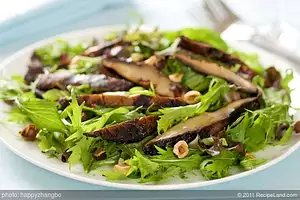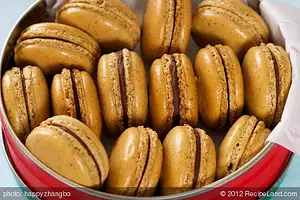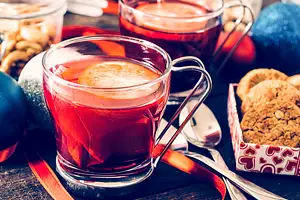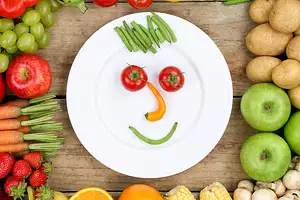With the growing popularity of low-carbohydrate or no carbohydrate diets, many of us have begun to look at all carbohydrates as the enemy. In reality, your body needs carbs to work efficiently and protect itself from disease.
Eating healthy carbohydrates can lower your risk of developing heart disease, type-2 diabetes, and help you lose weight! Most carbs are full of fibre to make you feel full and satisfied throughout the day. Carbohydrates also provide your body with the fuel it needs to get through your daily routine.
Many of the “good carbohydrates” in our diet come from fruits and vegetables. These tend to be high in fibre and low in calories. Other “good carbohydrates” like whole grains and dairy are higher in calories, but are still a good choice for achieving and maintaining your weight loss goals.
You want to avoid carbohydrates that are packed with sugar or made with refined flour. These “bad carbohydrates” are very high in calories, can cause weight gain, and do not offer much nutritional value.
When choosing which carbohydrates to add to your diet, look for carbs that are high in fibre, like beans, fruits, veggies, and whole grains. These “good carbs” are digested slowly by your body, giving you energy over a period of time and regulating your blood sugar levels. The fibre in these carbohydrates keeps your digestive tract working properly and can help prevent colon cancer.
Fibre from beans, oats, and some fruits can also lower your cholesterol levels to keep your heart healthy.
One study from the National Academies Institute of Medicine found that eating carbohydrates can lower your risk of developing chronic disease. Participants who ate 45-65% of their daily calories from carbohydrates saw a reduced risk of chronic disease.
Enjoy plenty of fruits and vegetables, along with these “good carbs” to see a smaller waistline and better health overall:
Whole-Wheat : Many varieties of whole wheat pasta have two to three times more fibre than white pasta. Whole-wheat bread and brown rice are also rich in fibre. Follow the package instructions for cooking whole wheat products, as it is often different from cooking white rice or pasta made with refined flour. Whole wheat breads and pastas and brown rice also add a delicious texture and nutty flavour to your favourite dishes.
Substitute whole-wheat products in your family’s favorite meals or try these recipes: Roasted Eggplant, Pepper and Garlic with Whole Wheat Pasta, Cashews, Lentils and Brown Rice Stuffed Portobello Mushrooms, 100% Whole Wheat Pita Bread, or Baked Spiced Apple French Toast.
*Quinoa: * Packed with protein and fibre, this whole grain keeps you feeling full and fuelled throughout the day. Be sure to rinse off quinoa to remove the bitter taste caused by its protective coating.
Quinoa is also low in sodium and full of phosphorus, magnesium, and manganese. Quinoa is easy to prepare in your own kitchen. Bring 2 cups of vegetable broth to a boil and stir in 1 cup of rinsed quinoa. Reduce heat and simmer with the lid on for 15 minutes or until all of the broth is absorbed. Fluff with a fork and serve. You can bake with quinoa, fold it into salads, or use it instead of pasta.
Try quinoa in these recipes: Buttermilk, Maple Syrup, Quinoa and Pecan Muffins, Quinoa and Arugula Salad with Pears, Walnuts, Dried Fruits, and Jack Cheese, Black Bean and Quinoa Salad, or Quinoa, Blueberry and Yogurt Parfait.
*Barley: * Both pearl and quick-cooking barley are excellent choices for your diet. Barley contains soluble fibre to lower cholesterol for a healthy heart. To prepare pearl barley, stir 1 cup of barley into 2 ½ cups vegetable broth and bring to a boil. Reduce heat and simmer 45 minutes or until all of the broth is absorbed. Allow the barley to stand for 10 minutes, and then serve.
To prepare quick-cooking barley, bring 1 ¾ cup vegetable broth to a boil and add 1 cup of barley. Simmer for 10 minutes. Serve. Use barley to thicken soups and stews or try it in these recipes: Barley Egg Rolls, Barley Casserole, or Breakfast Barley.
*Bulgur: * Bulgur is easy to prepare and packed with fibre. You only need to eat ½ cup of cooked bulgur to get 5 grams of fibre. Bring 1 ½ cups vegetable broth to a boil. Place 1 cup of bulgur in a large bowl and pour in the boiling broth. Cover and let stand for 30 minutes, or until the broth is absorbed and the bulgur is light and fluffy.
Bulgur can give texture to casseroles and is delicious in salads or prepared with brown sugar and dried fruit for breakfast. Add bulgur to your diet with these tasty recipes: Tabouli, Bulgur Wheat Pilaf with Mushrooms, Ancient Grain Salad, Butternut Squash and Yam Casserole, and Apple Bulgur Breakfast.
*Popcorn: * If you want a healthy and crunchy snack, grab popcorn! One serving of this whole grain has 3 grams of fibre! Use an air popper to prepare popcorn without adding any fat. Add your favourite spice blend to give extra flavour to your air-popped popcorn or try these recipes for a new twist: Cranberry and Ginger Popcorn Balls, Popcorn Muffins, or Popcorn Macaroons.
Oatmeal : Oatmeal is full of soluble fibre to lower your cholesterol and reduce hunger. There are many types of oatmeal available: rolled oats, quick-cooking oats, steel-cut oats, and instant oatmeal. All varieties can be made on the stovetop or in the microwave. Follow package instructions to prepare the type of oats you choose.
Make oatmeal for breakfast, add it to baked goods, fold it into granola, or use it to bind ground meat dishes. Try these recipes to work oatmeal into your diet: Alex’s Oatmeal, Soft Oatmeal Cookies, Oatmeal Blueberry Muffins, and Oatmeal Biscuits.
Beans: Beans are packed with nutrients to keep you full and energized. They are full of fibre and protein, but low in fat. They are also low in sugar to help regulate your blood glucose levels. Open up a can of beans or prepare dried beans. Sort dried beans to remove debris and rinse off any dirt. Soak them overnight in enough water to cover plus a few inches.
The next day, drain off the soaking water and rinse the beans. Place them in a dutch oven and cover them with an inch of water or broth. Bring the liquid to a boil over high heat. Reduce the heat to low and simmer with the lid on for one hour or until the beans are tender.
Use beans to give taste and texture to salads and chili or use them as the base of casseroles and main dishes.
Try these delicious recipes to add a variety of beans to your diet: Homemade Refried Beans, South American Quinoa and Black Beans, Peanut Butter, Chocolate Chip and Chickpea Cookies, and Kidney Bean and Barley Chili.
Source:
https://www.shape.com/weight-loss/food-weight-loss/best-carbs-weight-loss










Comments